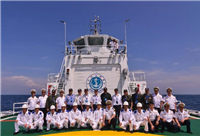

 |
| File photo |
Premier’s Latin America visit likely to push deal
Premier Li Keqiang's upcoming visit to Latin America is expected to push forward the railroad project connecting the Pacific and Atlantic, a move that will help boost economies in the region and also reinforce Sino-Latin American trade, analysts told the Global Times Thursday.
Li is set to pay official visits to Brazil, Colombia, Peru and Chile from Monday to May 26, which will shore up China's trade ties with the four countries, Xinhua reported Wednesday, citing Vice Foreign Minister Wang Chao.
During his visit to Brazil, Li will sign a series of documents with Brazilian officials, including a joint research paper about the feasibility of building a railroad corridor from Peru's Pacific coast to Brazil's Atlantic coast, according to Xinhua.
A railroad project connecting the Pacific and Atlantic would relieve pressure on the Panama Canal, which has been seeing increasing freight traffic in recent years, Bai Ming, a research fellow at the Chinese Academy of International Trade and Economic Cooperation, told the Global Times on Thursday.
"The railway will also improve connectivity between Asia-Pacific and Latin America," Bai noted.
Brazil has been pushing forward with upgrading its infrastructure because the government is aware of the importance of transport infrastructure to trade, Zhou Zhiwei, a research fellow who specializes in Latin America with the Chinese Academy of Social Sciences, told the Global Times on Thursday.
"Building a railroad between the Pacific and the Atlantic can not only strengthen the economic ties between Asia-Pacific and Latin America but also help regional economic growth," Zhou said.
Zhou also noted that infrastructure remains underdeveloped in Latin American countries like Brazil and Peru, and this is one of the main obstacles to regional development.
Chinese President Xi Jinpingproposed the transcontinental railway initiative in July 2014, and his Brazilian and Peruvian counterparts later agreed to participate in it.
Later that same month, Xi emphasized the importance of cooperation between China and Latin America, particularly in areas like trade and finance. He also highlighted six key investment fields for Chinese firms in Latin America, such as resources, infrastructure and agriculture.
As infrastructure is one of the key investment fields mentioned by Xi, it will be further encouraged in the next few years, Zhou noted.
Brazil is China's largest trading partner in Latin America, with trade volume between the two countries having reached $86.67 billion in 2014, the Xinhua report said, citing Tong Daochi, assistant minister of commerce.
Li's visit will bring more investment opportunities in trade, technology and telecommunications, Wang noted.
Infrastructure projects like the railway from Brazil to Peru will help local industries grow, an employee at the local Peru office of a Chinese State-owned enterprise who wished to remain anonymous, told the Global Times on Thursday.
"Peru has a leading position in the mining industry, but some mining areas are too far away from ports and main roads, which significantly increases transportation costs," he said.
He noted that as China is a major importer of copper from Peru, upgrading the infrastructure in the region would help boost trade between the two countries.
Bai noted that it is still unclear where the transcontinental railway will start and where it will end, as researchers need to come up with more precise plans in accordance with local geographic characteristics. "A more detailed plan will come out because the related countries have all shown interest in the project," Bai said.
 J-11 fighters in air exercise
J-11 fighters in air exercise Beauties dancing on the rings
Beauties dancing on the rings Attendants-to-be join Mr. & Miss Campus Contest
Attendants-to-be join Mr. & Miss Campus Contest Beijing's toughest anti-smoking law takes effect
Beijing's toughest anti-smoking law takes effect Family lives in cave for about 50 years in SW China
Family lives in cave for about 50 years in SW China PLA soldiers operating vehicle-mounted guns in drill
PLA soldiers operating vehicle-mounted guns in drill Blind carpenter in E China's Jiangxi
Blind carpenter in E China's Jiangxi China hosts overseas disaster relief exercise for the first time
China hosts overseas disaster relief exercise for the first time 20 pairs of twins who will become flight attendants in Sichuan
20 pairs of twins who will become flight attendants in Sichuan Obama is sowing discontent in S.China Sea
Obama is sowing discontent in S.China Sea Rescuers work through night to reach cruise ship survivors
Rescuers work through night to reach cruise ship survivors Driving through limbo
Driving through limbo Facing down MERS
Facing down MERSDay|Week